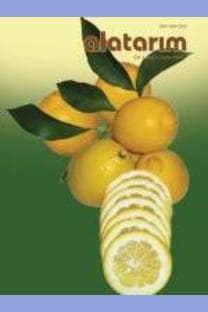Hıyar (Cucumis sativus L)' da rejenerasyonunun optimizasyonu
Çalışmanın amacı, hıyar'da farklı BA ve AVG konsantrasyonlarını deneyerek etkili rejenerasyon metodunu optimize etmektir. Rejenerasyon ortamı olarak AVG'nin 0.0, 0.5 ve 1.0 mg/1, BA'nin 0.0, 0.5, 1.0 ve 2.0 mg/1 konsantrasyonlarını içeren MS (Makro, Mikro ve Vitamin) ve katılaştırıcı olarak da Phytagel (3 g/l) kullanılmıştır. Denemede 'flamingo bili' eksplant tipi denenmiştir. Denemenin sonucunda, en yüksek rejenerasyon oranı, 0.5 mg/1 AVG ve 0.5 mg/1 BA ilave edilmiş MS ortamından %87.5 oranında elde edilmiştir. Ortama AVG'nin eklenmesi ile rejenerasyon oranı artmıştır. Ancak, AVG'nin yüksek konsantrasyonunda (lmg/1) rejenerasyon oranınınm düştüğü gözlenmiştir.
Anahtar Kelimeler:
hıyar, etilen, AVG, bitki büyüme düzenleyicileri, benziladenin, Cucumis sativus, gençleştirme
The optimisation of regeneration in cucumber (Cucumis sativus L)
The aim of this study is to optimize the rejeneration protocol in cucumber using different concentration of BA and AVG. In regeneration medium, MS medium containing 0.0, 0.5 and 1.0 mg/1 AVG, 0.0, 0.5, 1.0 and 2.0 mg/1 BA and 3 mg/1 phytagel were used. In this study, flamingo bill explant type was used. The highest regeneration ratio (87.5 %) was obtained from MS medium containing 0.5 mg/1 AVG and 0.5 mg/1 BA. Regeneration capacity was induced by addition of AVG. However higher AVG concentration (1 mg/1) reduced regeneration ratio.
Keywords:
cucumbers, ethylene, AVG, plant growth regulators, benzyladenine, Cucumis sativus, regeneration,
___
- Anonim, (2003). Http.www.fao.org.
- Burza , W. ve Malepszy, S.(1995). In vitro culture of Cucumis sativus L. XVII. Plants from protoplasts through direct somatic embriyogenesis. Plant Cell, Tissue and Organ Culture. 41:259-266,1995.
- Chraibi, K. M.; Latche A.; Roustan, J. P. ve Fallot, J. (1991). Stimulation of shoot regeneration from cotyledons of Helianthus annus by the ethylene inhibitors, silver and cobalt. Plant Cell Rept. 10:204-207.
- Colijn-Hooymans, CM.; Hakkert, J.C.; Jansen, J.; Custer, J.B.M. (1994). Competence for regeneration of cucumber cotyledos is restricted to specific development stages. Plant Cell, Tissue and Organ Culture, 39: 211-217
- Ezura, H.; Yuhashi, K.I.; Yasuta, T. ve Minamisawa, K. (2000). .Effect of Ethylene on Agrobacterium Tumefaciens-Mediated Gene Transfer to Melon. Plant Breeding, v. 119, Issue 1, Page 75.
- Gambley, R.L.; Dodd, W.A. (1990). An in vitro technique for the production de novo of multiple shoots in cotyledon explants of cucumber (Cucumis sativus L.). Plant Cell, Tissue and Organ Culture. Experimental Cell Research, 20: 177-183.
- Islam, R.; Hoque, A.; Rahman, M.H.; Akad, A. (1999). Plant regeneration from hyppocotyl explants oiCitrullus lanatus Thunb. Pakistan Journal of Botany 31(1): 31-35
- Kim, J.W; Han, S.K; Kwon, S.Y.; Lee, H.S. ; Lim, Y.P.; Liu, J.R.; Kwak, S.S. (2000). High frequency shoot induction and plant regeneration from cotyledonary hypocotyl explants of cucumber (Cucumis sativus L.) seedlings. Journal of Plant Physiology, 157: 136-139
- Maciejewska-Potapczykowa, W.; Rennert, A. ve Milewska, E. (1972). Callus induction and growth of tissue cultures derived from cucumber plant organs of four different sex types. Acta. Societatis. Botanicorum Polloniae, 41: 329-339.
- Oldach, K.H.; Morgenstern, H.; Rother, S.; Girgi, M.; O'Kennedy, M. ve Lörz, H. (2001). Efficient in vitro plant regeneration from immature zygotic embryos of pearl millet [Pennisetum glaucum (L.) R. Br.] and Sorghum bicolor (L.) Moench . Plant Cell Reports DOI 10.1007/s002990100335
- Pua, E.C.; Sim, G.E.; Chi, G.L.; Kong, L.F. (1996). Synergistic effect of ethylene inhibitors and putrescine on shoot regeneration from hypocotyl explants of Chinese radish (Raphanus sativus L. var. longipinnatus Bailey) in vitro
- Vain, P.; Flament, P. ve Soudain, P. (1989a). Role of ethylene in embryogenic callus initiation and regeneration in Zea mays L. J. Plant Physiol. 135: 537-540.
- ISSN: 1304-2653
- Başlangıç: 2015
- Yayıncı: Alata Bahçe Kültürleri Araştırma Enstitüsü
Sayıdaki Diğer Makaleler
Giresun' da yetiştirilen bir kocayemiş (Arbutus unedo L.) tipinin bitkisel özellikleri
Turan KARADENİZ, Turgut ŞİŞMAN
Kırkağaç 637 kavun (Cucumis melo. L.) çeşidinde rejenerasyonunu optimizasyonu
Yalçın Yeşim MENDİ, MUZAFFER İPEK, Serbest Sinem KOBANER, Emre KÜKÜRT
Küreselleşme sürecinde ülkemiz arıcılığı için olası bir zararlı: Küçük kovan böceği (Aethina tumida)
Hıyar (Cucumis sativus L)' da rejenerasyonunun optimizasyonu
Yalçın Yeşim MENDİ, Serbest Sinem KOBANER, A. Fikret FIRAT
Bazı Amerikan asma anaçlarının yeşil aşı tekniğinde başarı ve performansları
Array gen ekspresyon teknolojisi ve bitkisel üretimde kullanımı
